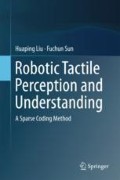Abstract
In this chapter, the investigated tactile data is regarded as time sequences, of which dissimilarity can be evaluated by the popular dynamic time warping method. A kernel sparse coding method is therefore developed to address the tactile data representation and classification problem. However, the naive use of sparse coding neglects the intrinsic relation between individual fingers, which simultaneously contact the object. To tackle this problem, a joint kernel sparse coding model is proposed to solve the multi-finger tactile sequence classification task. In this model, the intrinsic relations between fingers are explicitly taken into account using the joint sparse coding, which encourages all of the coding vectors to share the same sparsity support pattern. The experimental results show that the joint sparse coding achieves better performance than conventional sparse coding.
Access this chapter
Tax calculation will be finalised at checkout
Purchases are for personal use only
References
Bekiroglu, Y., Kragic, D., Kyrki, V.: Learning grasp stability based on tactile data and HMMs. In: RO-MAN, 2010 IEEE, pp. 132–137 (2010)
Bekiroglu, Y., Laaksonen, J., Jorgensen, J.A., Kyrki, V., Kragic, D.: Assessing grasp stability based on learning and haptic data. IEEE Trans. Rob. 27(3), 616–629 (2011)
Boyd, S., Vandenberghe, L.: Convex optimization (2004)
Chen, Z., Zuo, W., Hu, Q., Lin, L.: Kernel sparse representation for time series classification. Inf. Sci. 292, 15–26 (2015)
Cheng, H., Liu, Z., Hou, L., Yang, J.: Sparsity-induced similarity measure and its applications. IEEE Trans. Circuits Syst. Video Technol. 26(4), 613–626 (2016)
Dang, H., Allen, P.K.: Learning grasp stability. In: 2012 IEEE International Conference on Robotics and Automation (ICRA), pp. 2392–2397 (2012)
Donoho, D.L.: For most large underdetermined systems of linear equations the minimal \(l_1\)-norm solution is also the sparsest solution. Commun. Pure Appl. Math. 59(6), 797–829 (2006)
Drimus, A., Kootstra, G., Bilberg, A., Kragic, D.: Design of a flexible tactile sensor for classification of rigid and deformable objects. Rob. Autonomous Syst. 62(1), 3–15 (2014)
Hu, W., Li, W., Zhang, X., Maybank, S.: Single and multiple object tracking using a multi-feature joint sparse representation. IEEE Trans. Pattern Anal. Mach. Intell. 37(4), 816–833 (2015)
Huang, W., Sun, F., Cao, L., Zhao, D., Liu, H., Harandi, M.: Sparse coding and dictionary learning with linear dynamical systems. In: Proceedings of the IEEE Conference on Computer Vision and Pattern Recognition, pp. 3938–3947 (2016)
Kappler, D., Bohg, J., Schaal, S.: Leveraging big data for grasp planning. In: 2015 IEEE International Conference on Robotics and Automation (ICRA), pp. 4304–4311 (2015)
Liu, H., Guo, D., Sun, F.: Object recognition using tactile measurements: kernel sparse coding methods. IEEE Trans. Instrum. Meas. 65(3), 656–665 (2016)
Liu, H., Liu, Y., Sun, F.: Traffic sign recognition using group sparse coding. Inf. Sci. 266, 75–89 (2014)
Liu, H., Liu, Y., Yu, Y., Sun, F.: Diversified key-frame selection using structured \(l_{2,1}\) optimization. IEEE Trans. Industr. Inf. 10(3), 1736–1745 (2014)
Liu, H., Qin, J., Cheng, H., Sun, F.: Robust kernel dictionary learning using a whole sequence convergent algorithm. In: IJCAI, vol. 1, p. 5 (2015)
Liu, H., Qin, J., Cheng, H., Sun, F.: Robust kernel dictionary learning using a whole sequence convergent algorithm. IJCAI 1(2), 5 (2015)
Liu, H., Sun, F.: Fusion tracking in color and infrared images using joint sparse representation. Sci. China Inf. Sci. 55(3), 590–599 (2012)
Liu, H., Yuan, M., Sun, F.: RGB-D action recognition using linear coding. Neurocomputing 149, 79–85 (2015)
Liu, H., Yuan, M., Sun, F., Zhang, J.: Spatial neighborhood-constrained linear coding for visual object tracking. IEEE Trans. Industr. Inf. 10(1), 469–480 (2014)
Madry, M., Bo, L., Kragic, D., Fox, D.: ST-HMP: Unsupervised spatio-temporal feature learning for tactile data. In: 2014 IEEE International Conference on Robotics and Automation (ICRA), pp. 2262–2269 (2014)
Mairal, J., Bach, F., Ponce, J., et al.: Sparse modeling for image and vision processing. Foundations Trends® Comput. Graphics Vis. 8(2-3), 85–283 (2014)
Shekhar, S., Patel, V.M., Nasrabadi, N.M., Chellappa, R.: Joint sparse representation for robust multimodal biometrics recognition. IEEE Trans. Pattern Anal. Mach. Intell. 36(1), 113–126 (2014)
Wright, J., Yang, A.Y., Ganesh, A., Sastry, S.S., Ma, Y.: Robust face recognition via sparse representation. IEEE Trans. Pattern Anal. Mach. Intell. 31(2), 210–227 (2009)
Zhou, F., Torre, F.: Canonical time warping for alignment of human behavior. In: Advances in Neural Information Processing Systems, pp. 2286–2294 (2009)
Author information
Authors and Affiliations
Corresponding author
Rights and permissions
Copyright information
© 2018 Springer Nature Singapore Pte Ltd.
About this chapter
Cite this chapter
Liu, H., Sun, F. (2018). Tactile Object Recognition Using Joint Sparse Coding. In: Robotic Tactile Perception and Understanding. Springer, Singapore. https://doi.org/10.1007/978-981-10-6171-4_3
Download citation
DOI: https://doi.org/10.1007/978-981-10-6171-4_3
Published:
Publisher Name: Springer, Singapore
Print ISBN: 978-981-10-6170-7
Online ISBN: 978-981-10-6171-4
eBook Packages: Computer ScienceComputer Science (R0)

